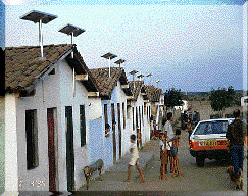

| Case studies | |||||
| Open-Air
Swimming Pool in Noerdlingen, Germany On condition that all the water would be heated exclusively by solar energy, this public pool in Germany was remodeled in the early nineties. The most striking feature of the design are the shallow slanted roofs. These roofs follow the slope of the natural hillside and also provide maximum surface for contact with the sun during the summer months. Statistics show that people return to the pools on the second day after the sun returns - roughly the time needed by the 1400m2, 850 kW solar system to raise the water temperature to the required level. A computer system controls the water flow from the pool through the regulating mechanism and the solar system. Here, the temperature of the water is increased by 5-10 degrees as it passes through solar storage mats on top of the roof (Figure 4). A 60m2 photovoltaic system with a maximum capacity of 7kW (7000 kWh/year) generates energy that is fed into the electrical network of the bath. |
|||||
|
|||||
| Baden-Wuertemberg
State Garden Show in Pforzheim The solar concept tries to explain the "complex oneness of environment and industry" using 5 solar conversion systems. In this system, solar radiation is transformed into passive or transportable warmth, power and electric current. The transformed solar energy is then put to use in nearby gardens. The gardens attempt to connect historical elements with the modern use of alternative energy. A shallow collector heats a pavilion which takes the form of a ruin. Solar radiation heats and regulates the climate of a greenhouse on a Mediterranean terrace, and a concave mirror bundles sunlight in order to drive a Stirling engine whose functioning depends on the temperature difference between two media. The resultant movement is transformed into electric current by means of a dynamo, which drives a pump. Water is transported from a cistern into the piping of an irrigation system which sensibly provides water for a fern and moss garden. Thus, the garden clearly depends on the sunshine - the greater the radiation, the greater the need for irrigation, the greater the water supplied. |
|||||
| U.S. Forest Service
Cholla Campground, Phoenix AZ At this public campground, solar power is used to generate lighting, air conditioning, and ventilation for the welcome center (Figure 5) and toilet facilities. |
|||||
|
|||||
 |
Cacimbos- |
||||
| Xcalak The people of Xcalak, a remote village on the east coast of the Yucatan peninsula, wanted to replace their diesel generators because of the cost of shipping fuel to the village, and because the generators continually broke down. Located 68 miles (110 km) from the nearest utility line, the village of 350 residents could not convince the utility to spend $3.2 million for an extension. The villagers then asked their government for help, and were provided with a hybrid system that combines solar electric modules and wind turbines with the existing diesel generating system. This hybrid system offered many advantages. Construction costs were be a fraction of those required for a line extension, and fuel and maintenance expenses were be lower than those for running the diesel generators alone. The system itself has greater generating capacity, and thus provides more homes and businesses with electric power. Finally, the hybrid system is more reliable than diesel generators operating alone because it includes multiple backup generators and a larger battery bank. |
|||||

